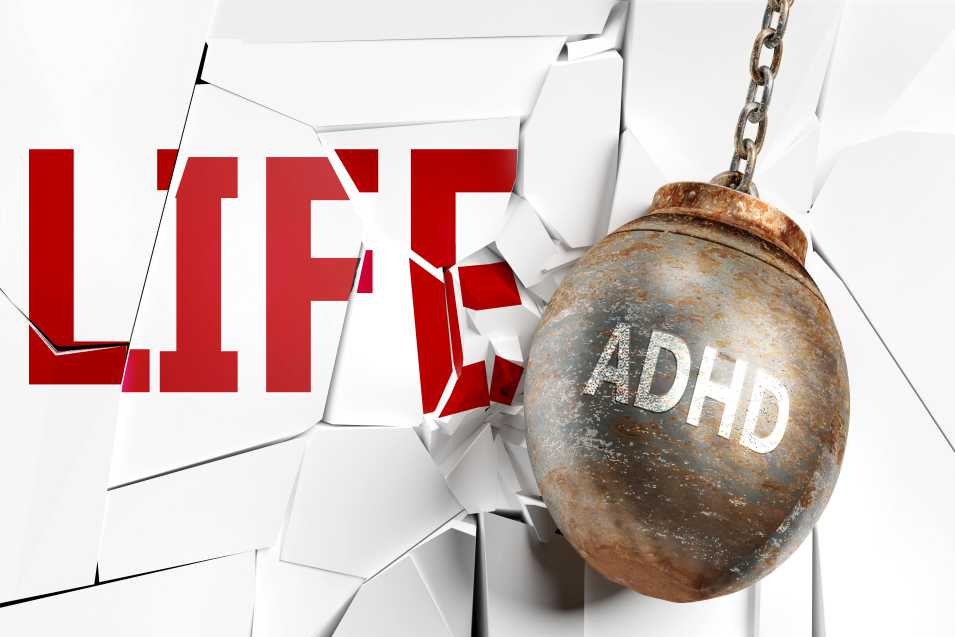
Attention Deficit Hyperactivity Disorder (ADHD) is a neurodevelopmental disorder that affects individuals of all ages. While it is commonly associated with symptoms of impulsivity and inattention, recent research has shed light on another aspect of ADHD: object permanence. In this article, we will delve into the connection between ADHD and object permanence, exploring how these cognitive threads intertwine.
Object permanence refers to an individual's ability to understand that objects continue to exist even when they are out of sight. It is a fundamental concept in cognitive development and plays a crucial role in memory, problem-solving, and overall mental abilities. However, studies have shown that individuals with ADHD may exhibit difficulties in grasping this concept.
One possible explanation for the link between ADHD and object permanence lies in executive functions. Executive functions encompass a set of cognitive processes responsible for self-regulation, decision-making, and attention control. Deficits in executive functions are often observed in individuals with ADHD, and these deficiencies can impact the understanding of object permanence.
Moreover, working memory, a component of executive functions, also plays a significant role in object permanence. Working memory allows us to temporarily store and manipulate information in our minds. Individuals with ADHD often struggle with working memory, which can further hinder their ability to maintain a mental representation of objects that are no longer visible.
The impact of poor object permanence in individuals with ADHD extends beyond childhood. Difficulties in this area can influence academic performance, social interactions, and daily activities. For instance, a child with ADHD may struggle to remember where they placed their belongings, leading to frustration and disorganization. Similarly, an adult with ADHD might face challenges in planning and organizing tasks due to their weakened object permanence skills.
Recognizing the connection between ADHD and object permanence can aid in the development of targeted interventions. Cognitive training programs that focus on improving executive functions and working memory may help enhance object permanence abilities in individuals with ADHD. Additionally, incorporating strategies such as visual cues, checklists, and organizational systems can assist in compensating for the difficulties associated with object permanence.
ADHD and object permanence are intertwined cognitive threads that warrant attention. The deficits in executive functions and working memory commonly observed in individuals with ADHD contribute to difficulties in understanding and applying object permanence concepts. By understanding this connection, tailored interventions can be developed to support individuals with ADHD in overcoming these challenges and improving their overall cognitive functioning.
The Link Between ADHD and Object Permanence: Unraveling the Cognitive Puzzle
Attention Deficit Hyperactivity Disorder (ADHD) is a neurodevelopmental disorder that affects individuals of all ages. Characterized by symptoms such as inattention, hyperactivity, and impulsivity, ADHD has been the subject of extensive research. However, there is one aspect of cognitive development that has gained attention in recent years—the link between ADHD and object permanence.
Object permanence refers to the understanding that objects continue to exist even when they are out of sight. It is a crucial cognitive milestone achieved during infancy. Researchers have noted that individuals with ADHD often struggle with this concept, leading to difficulties in organizing their environment and maintaining focus. Understanding this connection can provide valuable insights into the cognitive processes underlying ADHD.
The relationship between ADHD and object permanence can be attributed to executive function deficits commonly observed in individuals with ADHD. Executive functions refer to a set of cognitive processes responsible for goal-directed behaviors, including working memory, inhibitory control, and cognitive flexibility. Impairments in these areas can impact an individual's ability to hold information in mind, inhibit distractions, and switch between tasks. Consequently, it becomes challenging to maintain a mental representation of objects in the absence of visual cues.
Moreover, the impact of object permanence difficulties on individuals with ADHD extends beyond the cognitive domain. It can influence social interactions and emotional regulation. Difficulties in organizing and locating personal belongings may lead to frustration and anxiety, while impaired object permanence can affect relationships due to difficulties in perceiving others' perspectives.
Addressing the link between ADHD and object permanence requires a comprehensive approach. Interventions targeting executive function skills, such as cognitive training and organizational strategies, can help individuals with ADHD improve their object permanence abilities. Additionally, providing environmental supports, such as visual cues and structured routines, can assist in compensating for the difficulties associated with object permanence.
understanding the link between ADHD and object permanence sheds light on the cognitive puzzle underlying this neurodevelopmental disorder. By recognizing the impact of executive function deficits and offering targeted interventions, we can support individuals with ADHD in developing their object permanence skills and ultimately enhance their overall cognitive and behavioral functioning.
Understanding Object Permanence in Individuals with ADHD: A Fascinating Exploration
Have you ever wondered how individuals with Attention-Deficit/Hyperactivity Disorder (ADHD) experience the concept of object permanence? Object permanence refers to the understanding that objects continue to exist even when they are out of sight. In this article, we will delve into the intriguing relationship between ADHD and object permanence, shedding light on the unique perspectives and challenges faced by individuals with this condition.
Individuals with ADHD often struggle with attention, impulsivity, and hyperactivity. These difficulties can manifest in various aspects of their lives, including their perception of object permanence. Studies have suggested that individuals with ADHD may exhibit delays or impairments in developing a full understanding of object permanence compared to their neurotypical counterparts.
The ability to grasp object permanence plays a crucial role in cognitive development. It allows us to comprehend the world around us, anticipate events, and make accurate predictions. For individuals with ADHD, the challenges they face in maintaining focus and attention can impact their ability to fully acquire and apply this concept.
Imagine a scenario where a child with ADHD is playing with a toy. When the toy is hidden from view, they may struggle to maintain its mental representation. This difficulty in retaining the presence of an object in their mind can lead to frustration and confusion, as they may expect the toy to vanish completely. Consequently, this may affect their problem-solving skills, as they find it challenging to reason about the location and existence of objects.
However, it is important to note that while individuals with ADHD may initially struggle with object permanence, their abilities can improve over time with appropriate interventions and support. Patience, consistent reinforcement, and engaging activities can help strengthen their understanding of object permanence and enhance their overall cognitive development.
the relationship between ADHD and object permanence is a fascinating area of exploration. By understanding the unique challenges faced by individuals with ADHD in grasping this concept, we can develop strategies and interventions to support their cognitive growth. Through patient guidance and tailored approaches, we can empower individuals with ADHD to navigate the world around them with confidence and a deeper understanding of object permanence.
How ADHD Impacts Object Permanence: Cognitive Discoveries and Implications
ADHD (Attention Deficit Hyperactivity Disorder) günümüzde oldukça yaygın bir dikkat bozukluğudur. Ancak, ADHD'nin sadece dikkat eksikliği ve hiperaktiviteyle sınırlı kalmadığı bilinmektedir. Bu makalede, özellikle nesne sürekliliği üzerindeki etkilerine odaklanacağız ve bilişsel keşifleri ile olası sonuçları inceleyeceğiz.
Nesne sürekliliği, nesnelerin varlığının veya durumunun, onları görmeye devam etmemize rağmen, geçici olarak bir yerden başka bir yere hareket ettiklerinde bile korunduğu bilişsel bir yetenektir. Bu yetenek, çevremizdeki dünyayı anlamamızda önemli bir rol oynar. Ancak, ADHD'li bireylerde nesne sürekliliği becerisinin etkilendiği bulgulara rastlanmıştır.
Dikkat eksikliği ve hiperaktivite belirtileri, ADHD'li bireylerin nesne sürekliliği konusunda zorluk yaşamasına yol açabilir. Odaklanma güçlüğü ve aşırı hareketlilik, nesneleri takip etmeyi ve onların hareketini sürekli olarak izlemeyi engelleyebilir. Bu da nesne sürekliliği becerisini etkileyebilir.
Bilişsel araştırmalar, ADHD'li bireylerin nesne sürekliliği konusunda daha düşük bir performans sergilediğini göstermektedir. Nesnelerin beklenmedik bir şekilde ortadan kaybolması veya görünmez olması durumunda, bu bireylerin nesnenin varlığını sürdürme yetenekleri azalabilir. Bu da nesne sürekliliği kavramını anlamada zorluk yaşadıklarını göstermektedir.
ADHD'nin nesne sürekliliği üzerindeki etkileri, çeşitli alanlarda önemli sonuçlar doğurabilir. Örneğin, okul öncesi dönemdeki çocuklar için nesne sürekliliği becerisinin gelişimi, matematik ve dil gibi kognitif becerilerin temelini oluşturur. Bu nedenle, ADHD'li çocukların eğitim sürecinde desteklenmeleri ve nesne sürekliliği becerilerinin geliştirilmesine odaklanılması önemlidir.
ADHD'nin nesne sürekliliği üzerindeki etkileri ve bilişsel keşifleri, bu bozukluğun karmaşıklığını anlamamız açısından önemlidir. ADHD'li bireylerin nesne sürekliliği becerilerinin zayıflığı, günlük yaşamlarında karşılaşabilecekleri zorlukları vurgulamaktadır. Bu nedenle, bu konuda daha fazla araştırma yapılması ve uygun müdahalelerin geliştirilmesi gerekmektedir.
Revealing the Hidden Connections: ADHD, Object Permanence, and Cognitive Development
Have you ever wondered about the link between ADHD, object permanence, and cognitive development? These seemingly unrelated concepts actually share a fascinating connection that sheds light on the complexities of human cognition. In this article, we will explore how ADHD impacts object permanence and its implications for cognitive development.
Firstly, let's delve into the concept of ADHD. Attention Deficit Hyperactivity Disorder (ADHD) is a neurodevelopmental disorder characterized by difficulties in sustaining attention, impulse control, and hyperactivity. It affects individuals across various age groups, with symptoms often persisting into adulthood. Research has shown that individuals with ADHD may struggle with executive functions, such as working memory and cognitive flexibility.
Now, let's consider the role of object permanence in cognitive development. Object permanence refers to the understanding that objects continue to exist even when they are out of sight. It is a crucial milestone in a child's cognitive development, typically acquired during infancy. This ability allows children to form mental representations of objects and engage in symbolic play. However, studies have demonstrated that children with ADHD may experience delays in acquiring object permanence compared to their typically developing peers.
So, what is the underlying connection between ADHD, object permanence, and cognitive development? One hypothesis suggests that the impaired executive functions associated with ADHD contribute to difficulties in establishing object permanence. Executive functions play a vital role in attention regulation and working memory, which are essential for forming and retaining mental representations of objects. Consequently, deficits in executive functions may hinder the development of object permanence skills in individuals with ADHD.
Understanding the relationship between ADHD, object permanence, and cognitive development can have significant implications. By recognizing the impact of ADHD on object permanence, educators, parents, and healthcare professionals can provide targeted interventions to support children with ADHD in overcoming these challenges. Early intervention strategies focusing on executive function training and object permanence can potentially enhance cognitive development in individuals with ADHD.
the hidden connections between ADHD, object permanence, and cognitive development offer valuable insights into the complexities of human cognition. By investigating how ADHD impacts object permanence, we gain a deeper understanding of the challenges faced by individuals with ADHD in their cognitive development journey. This knowledge opens doors for tailored interventions and support that can positively influence the lives of those affected by ADHD.
